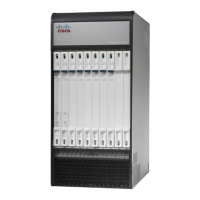Rear Cards
The ASR 5500 supports several types of rear-mounted cards:
•
Management I/O, on page 9
•
Data Processing Card, on page 10
–OR–
•
Data Processing Card version 2, on page 10
The ARS 5500 supports ten rear cards. Each card is interconnected with the others via the switching fabric.
UMIO cards, UDPCs and UDPC2s are direct replacements for MIO cards and DPC/DPC2s. However, a
special Universal PID license must be purchased and installed on the chassis for each installed UMIO and
UDPC/UDPC2. Contact your Cisco account representative for additional information.
Important
Management I/O
The ASR 5500 chassis supports two MIO /UMIO cards placed in the rear facing slots of the chassis. These
cards perform chassis management, as well as local context and non-local context external I/O operations.
The MIO/UMIO cards automatically implement 1:1 port redundancy (active/standby). Ports are 1:1
redundant across slots 5 and 6. For example, port 10 on the MIO in slot 5 is redundant with port 10 on the
MIO in slot 6.
Important
Each MIO/UMIO has:
•
One CPU subsystem with 96 GB of RAM
•
Four NPU subsystems
The two 10/100/1000Base-T (1GbE) ports on the front panel of MIO/UMIO cards can only be used for local
context (OAM). An MIO/UMIO includes support for:
•
Midplane connections for chassis control operations
•
SAS storage controller for FSC solid state drives (SSDs)
•
RS-232 serial console (RJ45) for CLI management
•
USB port for an external flash device
•
32 GB SDHC internal flash device
MIO/UMIO cards support two daughter card (DCs) for external I/O interfaces (100 Gbps aggregate per DC).
The optical ports on the daughter cards can only be used for non-local context. The currently available DC
supports ten 10 GbE interfaces. The interface ports accept SFP+ SR and LR transceivers.
For additional information see the MIO Cabling chapter.
ASR 5500 Installation Guide
9
ASR 5500 Hardware Platform Overview
Rear Cards

